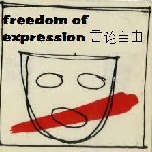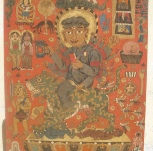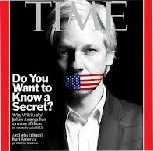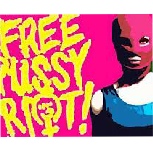


"Pop artist gives an 'English' lesson"
By Jeff Theodore | Journal Arts Editor - Friday, November 02, 2007
If you have an aversion to being the subject of a painting, don't bother getting to know Ron English.
"It's known that if you're part of an artist's life, you'll become part of one of their paintings," says English, a celebrated painter who labels the controversial yet dynamic visuals he creates a version of social commentary called "Popaganda."
When the longtime Jersey City artist, who once had a studio in the now defunct 111 First St. building, had his own kids they didn't stand a chance. They were instantly recruited as models for his work.
Now, wherever English's children, Zephyr, 12, and Mars, 9, go they're also known as "Kiss Kids." Several visuals in English's new book, "Son Of Pop: Ron English Paints His Progeny," ($35, 9 MM Books), depict English's children as members of Kiss, one of English's favourite bands.
"Pop," already in bookstores, is one of two books in which English has compiled his work. The other one, "Abject Expressionism," ($50, Last Gasp Publishing), a retrospective of his artistic career, hits bookshelves next month.
English says his children, although sometimes begrudgingly, went along with the program of being a part of daddy's work.
"As they got older they started to understand the process," English says. "I would say, 'Hey, Mars, I want you to look really pensive' and he would do it. However, I do think it's annoying to him because he'd rather be playing video games. My daughter, Zehphyr, however, seems more interested."
Since English himself was a child growing up in a rural Illinois town, he says he's known art would be his lifelong calling.
"I remember being a 4-year-old and having this dream of a stupid bridge in my hometown collapsing," he says. "In the dream, I'm an old man who's crossing the bridge in a car with eight paintings in the back seat. I'm thinking that I'm going to die, but more so that those paintings are going to die, too."
English says his mother was an adept painter, too, but hid her passion for it.
"She would throw her art away in the garbage," he says. "My father, I guess, didn't want her doing that kind of stuff. But, it was good. There was this weird prejudice against art."
English has taken heat and found himself in sketchy circumstances for transforming commercial billboards into socio-political messages. McDonald's, for one, has been in the line of fire of English's wrath. English's Ronald "McSupersize" paintings got prominent play in the popular documentary "Super Size Me."
English says his mother was an adept painter, too, but hid her passion for it.
"She would throw her art away in the garbage," he says. "My father, I guess, didn't want her doing that kind of stuff. But, it was good. There was this weird prejudice against art."
English has taken heat and found himself in sketchy circumstances for transforming commercial billboards into socio-political messages. McDonald's, for one, has been in the line of fire of English's wrath. English's Ronald "McSupersize" paintings got prominent play in the popular documentary "Super Size Me."
"I want to make art that has a political significance but isn't a political cartoon," he says. "My intent is for it to be more universal and less dogmatic."
English found his way to Jersey City after rents for studio and living space in New York City rose through the roof.
"It went from $4,000 to $12,000 a month," he says. "Since my wife and I had many good friends here and wanted to raise our kids in a nicer environment with parks, we decided to move here."
No matter where he's doing his art, English says it reaches many more eyes than ever before.
With the stakes so high, does that translate into bigger headaches?
"No, I love it," he says. "If I was an artist in 1959, I would have to be an abstract expressionist. Now, you can do whatever you want. Now, I can be Ron English and absorb everything."
Ron English - Art Terrorist, by Chris Mitchell
Featured Article November 2007 Ron English does to civilised discourse what a jalapeño does to an ice-cream sundae.
He shakes up the norm. Turns it upside down. He asserts himself into ordinary situations with such intensity that you have to absorb his message, even if it means you want to brain him with a baseball bat. Which, in English's case, is a fair measure of success.
He started by setting his friend on fire.
To be fair here, his friend asked for it. Ron was young then, high school age, and he had discovered the art of 8 mm film. He and a group of pals were recording themselves doing wacky stunts, each one crazier and more life-threatening than the last. When one of the guys accidentally caught on fire, they stumbled onto a formula that took Jackass two more decades to figure out: people on fire are cool. And so Ron's friend doused himself in lighter fluid and Ron rolled the camera.
˜The interesting thing about making the movies,' says English, ˜is that they were silent, so you had to get up and narrate. So I would throw parties and have bands play and then, between the bands, we would come out and play the movie. It was like the centre of our social life.'
Ironically, Ron's 8 mm film career ended in fire at an award banquet when the same friend, in an accidental encore performance, caught fire and had to be rushed to the hospital where he was treated for second-degree burns. From that point on, the only person who would feel the painful wrath of English's art was English.
When he left high school, he enrolled in art college. He intended to study commercial art, but something didn't feel right.
˜This guy stood up at orientation day and said, This is gonna be the hardest thing you ever do in your life. It's gonna be hard beyond your wildest expectations. And I thought, you know what? I'm gonna party. And I walked out.'
He only made it as far as the classroom next door where they were orienting students for a career in fine art photography. At that point, fine art photography barely existed as a career, and that suited English just fine. ˜The funny part is,' English concedes. ˜I worked way harder than the kids did in advertising. So there you go.' It wasn't long before English did break into advertising ¦ In his own way.
Ron English is to polite society what a hand grenade is to a diplomatic luncheon on the Gaza strip.
English is about to release two books of paintings, Son of Pop, which features his children dressed up in different outfits he bought off eBay, and Abject Expressionism, featuring the best paintings of his life. These are the works that he does on traditional canvases, shown in galleries around the world. What readers outside of America may not have seen, however, are his billboards.
He started designing billboard art as backgrounds for his photo projects, but they quickly took on a life of their own. In 1984, he and a group of like-minded artists formed The New Urban Aesthetics Committee, an imaginary organisation devoted to the ˜liberation' of billboards.
He quickly developed a style to his exhibitions, working in broad daylight so as not to arouse too much suspicion, working with a minimal number of people and keeping the cars running for a quick getaway. His style has always had a legitimate feel, using actual corporate logos and realistic branding. The message is between the lines.
Many of his art projects end up as social engagements. When I suggest that he is only creative as an excuse to party, he laughs. ˜I started off as a shy kid, sitting at home, drawing underground comic books, so it was nice that I was able to use art to get a social life.'
Ron English is to conservative culture what a schoolgirl's uniform and headmaster's discipline stick is to the missionary position.
Music has always been an integral part of English's creative process. He had a big house in college, but no stereo, so he concocted a scheme to surround himself with music. ˜I would let these eleven bands rehearse there. I'd say, You can practice at my house, but, in exchange, you have to play at my parties, which they wanted to do anyway.'
One day, after moving to New York, English was watching a documentary about Saddam Hussein on the History Channel. The story revealed that Saddam had 110 songs about him, and English thought to himself, ˜I can do better than that.' So he set out on a mission to break Saddam's record.
The first CD, Ron English 101, was released on a small label out of San Francisco featuring songs from The Gefkens, The Sutcliffes, Baby Snufkin and Charles Herold. It didn't exactly top the charts, but it was a feat that Saddam never accomplished. And in the end, English beat Hussein's record.
At one point, English's New York loft burned down. This left him with no home and nowhere to paint for six months. So he read The Bible. Although he had had many of his shows shut down by Christian groups, he had never before read the Good Book, and he was surprised at how much of it appealed to him.
He was particularly inspired by the words of Jesus in the Gnostic Gospel According To Thomas: ˜If you bring forth what is within you, what you bring forth will save you. If you do not bring forth what is within you, what you do not bring forth will destroy you'.
What was in him next, he decided, was a tour of the Bible Belt of America, featuring himself as Jesus. For his first gallery opening in Austin, English sent out invitations to all the churches, and created a big billboard with a quote from the King James Bible: ˜I did not come to bring peace into this world ¦ For the son dishonoured the father, the daughter rised up against her mother, the daughter in law against her mother in law; a man's enemies are the men of his own house'.
The good Christian people of Austin responded well to the ad because English himself was featured on the billboard as the Son of God with his long blond hair and blue eyes. But it didn't take long for them to realise the controversial nature of the exhibit. They confronted English as an angry, puritanical mob.
˜We started arguing, and then I ripped a page out of the Bible and said, Do I have the right to do that? and they said Hell no. And I said, Are you sure that I don't have the right to edit the Bible? and they said, No. The Bible is absolute. So I said, Then how did Constantine get the power? And they said, Well, he probably shouldn't have. And once I got them to agree with that, I was able to open them up to a lot of other ideas.'
It was a shining moment in Christian“Agnostic diplomacy that wouldn't last. In 2005, he erected a billboard of Jesus holding a Budweiser with the message, THE KING OF THE JEWS FOR THE KING OF BEERS. Over 200 Christian radio stations blew up the airwaves.
˜I started calling the stations, saying, I'm the guy you're talking about. Can I say what I think about all this? And they said, No!.'
Ron English is to moral rectitude what a fart is to Sunday morning mass.
One day, English's wife dared him to put up an especially controversial billboard. Never one to back down from a challenge, he created the piece, and then wrangled some friends into two vehicles to find the perfect spot for his new installation.
˜Most of these billboards are planted in people's yards in lower income neighbourhoods,' English says. ˜And they'll bring out lawn chairs and they'll bring you drinks, and think it's so cool because they despise the fact that there's a billboard stuck to the side of their building promoting cigarettes and beer to their kids.'
On this particular day, English warned his crew that the reaction might not be so positive. They parked their cars in front of a billboard in a New York neighbourhood where a dozen Puerto Rican guys were sitting on the steps across the street, drinking tall boys. Ron insisted on putting this one up alone, and asked that his crew keep the engines running. But somewhere between the excitement of a Ron English project and the festive atmosphere of the Puerto Rican posse, the situation became lax. The billboard that went up featured six cheery words:
LET'S GET DRUNK AND KILL GOD
As soon as they realised what it was, the Puerto Ricans ran inside the building, shouting ˜We're gonna fucking kill you!' Everybody jumped into the cars, except for Ron, who was being shut out after he accidentally stepped in dog shit. When the Puerto Ricans returned wielding baseball bats, English dove in and narrowly escaped.
While he has made enemies of Big Tobacco, the Republican party and every religion in the world, he has a devoted army of fans who love him. Recently, in Las Vegas, a team put up two more of his billboards. The first, an image of George W Bush in a forest said, EVOLUTION “ IT'S NOT FOR EVERYONE. The other one featured Paris Hilton with the message: WHERE'S YOUR BURKA BITCH?
In his 2004 book, Popaganda, English wrote, ˜It's been over twenty years since my first billboard and I'm still at it “ and why not? It's the ultimate form of free speech “ no censors, art directors, editors, corporations, just direct engagement with the public. I've been involved with the liberation of over a thousand billboards at this point, each one a unique hand-painted work sacrificed at the altar of the collective conscious. They cannot be owned and they cannot survive. They are finite moments consumed in a quick glance. At their best they outrage the complacent sensibilities of the viewer; at their worst they temporarily sidetrack the thought continuum, sending it off into an unexpected direction, if only for a moment.'
No matter what the medium, Ron English is passionate about his art. He has five characters out in vinyl, and he is embarking on a new music project with The Sutcliffes, featuring his son and daughter on back up vocals. For Ron English, every morning is the dawn of a new golden age, filled with the promise of revolution complete with soundtrack, fire and baseball bats.









